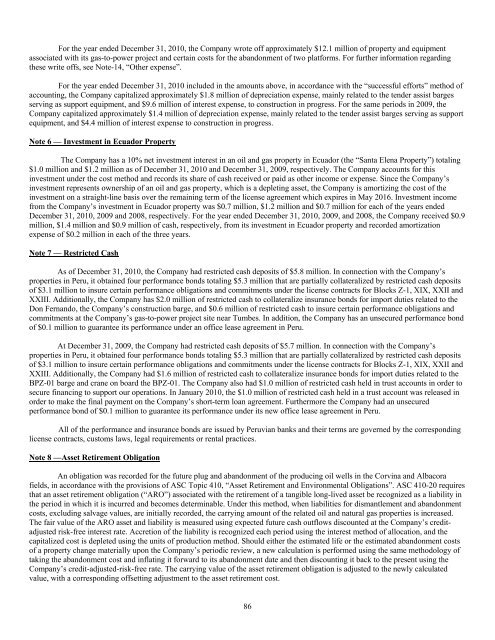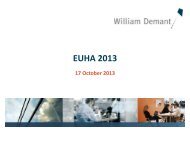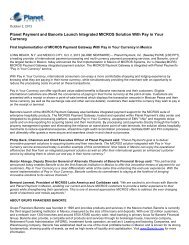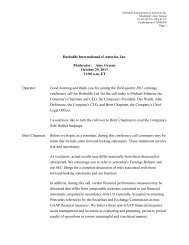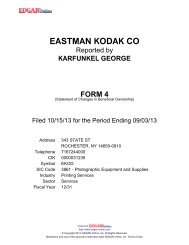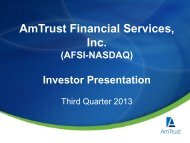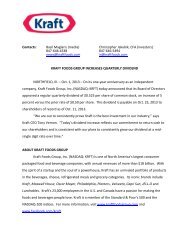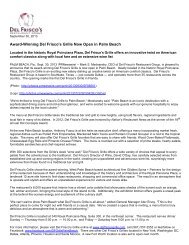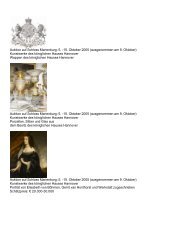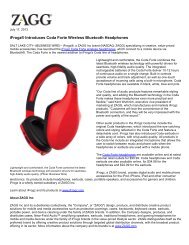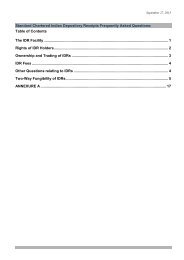BPZ Resources, Inc. - Shareholder.com
BPZ Resources, Inc. - Shareholder.com
BPZ Resources, Inc. - Shareholder.com
You also want an ePaper? Increase the reach of your titles
YUMPU automatically turns print PDFs into web optimized ePapers that Google loves.
For the year ended December 31, 2010, the Company wrote off approximately $12.1 million of property and equipment<br />
associated with its gas-to-power project and certain costs for the abandonment of two platforms. For further information regarding<br />
these write offs, see Note-14, “Other expense”.<br />
For the year ended December 31, 2010 included in the amounts above, in accordance with the “successful efforts” method of<br />
accounting, the Company capitalized approximately $1.8 million of depreciation expense, mainly related to the tender assist barges<br />
serving as support equipment, and $9.6 million of interest expense, to construction in progress. For the same periods in 2009, the<br />
Company capitalized approximately $1.4 million of depreciation expense, mainly related to the tender assist barges serving as support<br />
equipment, and $4.4 million of interest expense to construction in progress.<br />
Note 6 — Investment in Ecuador Property<br />
The Company has a 10% net investment interest in an oil and gas property in Ecuador (the “Santa Elena Property”) totaling<br />
$1.0 million and $1.2 million as of December 31, 2010 and December 31, 2009, respectively. The Company accounts for this<br />
investment under the cost method and records its share of cash received or paid as other in<strong>com</strong>e or expense. Since the Company’s<br />
investment represents ownership of an oil and gas property, which is a depleting asset, the Company is amortizing the cost of the<br />
investment on a straight-line basis over the remaining term of the license agreement which expires in May 2016. Investment in<strong>com</strong>e<br />
from the Company’s investment in Ecuador property was $0.7 million, $1.2 million and $0.7 million for each of the years ended<br />
December 31, 2010, 2009 and 2008, respectively. For the year ended December 31, 2010, 2009, and 2008, the Company received $0.9<br />
million, $1.4 million and $0.9 million of cash, respectively, from its investment in Ecuador property and recorded amortization<br />
expense of $0.2 million in each of the three years.<br />
Note 7 — Restricted Cash<br />
As of December 31, 2010, the Company had restricted cash deposits of $5.8 million. In connection with the Company’s<br />
properties in Peru, it obtained four performance bonds totaling $5.3 million that are partially collateralized by restricted cash deposits<br />
of $3.1 million to insure certain performance obligations and <strong>com</strong>mitments under the license contracts for Blocks Z-1, XIX, XXII and<br />
XXIII. Additionally, the Company has $2.0 million of restricted cash to collateralize insurance bonds for import duties related to the<br />
Don Fernando, the Company’s construction barge, and $0.6 million of restricted cash to insure certain performance obligations and<br />
<strong>com</strong>mitments at the Company’s gas-to-power project site near Tumbes. In addition, the Company has an unsecured performance bond<br />
of $0.1 million to guarantee its performance under an office lease agreement in Peru.<br />
At December 31, 2009, the Company had restricted cash deposits of $5.7 million. In connection with the Company’s<br />
properties in Peru, it obtained four performance bonds totaling $5.3 million that are partially collateralized by restricted cash deposits<br />
of $3.1 million to insure certain performance obligations and <strong>com</strong>mitments under the license contracts for Blocks Z-1, XIX, XXII and<br />
XXIII. Additionally, the Company had $1.6 million of restricted cash to collateralize insurance bonds for import duties related to the<br />
<strong>BPZ</strong>-01 barge and crane on board the <strong>BPZ</strong>-01. The Company also had $1.0 million of restricted cash held in trust accounts in order to<br />
secure financing to support our operations. In January 2010, the $1.0 million of restricted cash held in a trust account was released in<br />
order to make the final payment on the Company’s short-term loan agreement. Furthermore the Company had an unsecured<br />
performance bond of $0.1 million to guarantee its performance under its new office lease agreement in Peru.<br />
All of the performance and insurance bonds are issued by Peruvian banks and their terms are governed by the corresponding<br />
license contracts, customs laws, legal requirements or rental practices.<br />
Note 8 —Asset Retirement Obligation<br />
An obligation was recorded for the future plug and abandonment of the producing oil wells in the Corvina and Albacora<br />
fields, in accordance with the provisions of ASC Topic 410, “Asset Retirement and Environmental Obligations”. ASC 410-20 requires<br />
that an asset retirement obligation (“ARO”) associated with the retirement of a tangible long-lived asset be recognized as a liability in<br />
the period in which it is incurred and be<strong>com</strong>es determinable. Under this method, when liabilities for dismantlement and abandonment<br />
costs, excluding salvage values, are initially recorded, the carrying amount of the related oil and natural gas properties is increased.<br />
The fair value of the ARO asset and liability is measured using expected future cash outflows discounted at the Company’s creditadjusted<br />
risk-free interest rate. Accretion of the liability is recognized each period using the interest method of allocation, and the<br />
capitalized cost is depleted using the units of production method. Should either the estimated life or the estimated abandonment costs<br />
of a property change materially upon the Company’s periodic review, a new calculation is performed using the same methodology of<br />
taking the abandonment cost and inflating it forward to its abandonment date and then discounting it back to the present using the<br />
Company’s credit-adjusted-risk-free rate. The carrying value of the asset retirement obligation is adjusted to the newly calculated<br />
value, with a corresponding offsetting adjustment to the asset retirement cost.<br />
86


